Introduction
Tiger snakes are among the most well-known and feared reptiles in Australia, commonly acknowledged for their striking appearance and potent poison. This post aims to look into the ins and outs of the tiger snake's environment, distribution, actions, and what one can anticipate when encountering these remarkable creatures. By understanding where to locate them and how to browse possible dangers, you can value their duty in the ecological community while ensuring your safety and security.
Tiger Snake Habitat: Where to Locate Them and What to Expect
Tiger serpents are mainly found in southeastern Australia, consisting of Tasmania, where they thrive in a range of settings. Their flexibility permits them to occupy varied surfaces such as seaside areas, wetlands, grasslands, and also urban locations.
Geographical Distribution of Tiger Snakes
The geographical reach of tiger snakes expands across a number of Australian states. They are specifically common in:

- Tasmania: The Tasmanian tiger serpent is among one of the most identified subspecies. Victoria: Found near water bodies like rivers and lakes. New South Wales: Preferring bushland locations close to water sources. Western Australia: More typically seen around swamps and estuaries.
Understanding the geographical distribution is essential for both conservation efforts and public awareness pertaining to experiences with these snakes.
Preferred Environments of Tiger Snakes
Tiger snakes flourish in various environments. Below are some normal environments where they might be located:
Wetlands: They favor marshy or swampy locations where they can access prey easily. Coastal Regions: Near beaches or rocky coastlines provide abundant food resources like fish and amphibians. Forested Areas: Dense undergrowth uses sanctuary from killers while supplying searching grounds.Behavioral Patterns Connected to Habitat
Understanding tiger serpent habits within their environments is crucial for communication management:
- Nocturnal Activity: Tiger serpents tend to be a lot more active during golden hours (sunset and dawn), making them more difficult to spot throughout daytime. Territorial Nature: They display territorial habits; thus, it's paramount to respect their space if encountered.
This understanding can assist minimize undesirable interactions in between humans and tiger snakes.

Are Tiger Snakes Venomous?
Yes, tiger snakes are undoubtedly poisonous. Their venom has neurotoxins that can create paralysis and even fatality if untreated.
What Makes Their Venom Dangerous?
The strength of a tiger serpent's venom differs depending upon a number of aspects:
- Geographic location Individual health Quantity infused during a bite
Symptoms of a Tiger Serpent Bite
Recognizing signs and symptoms early is crucial:
- Pain at the bite site Swelling Difficulty breathing
Immediate clinical attention is crucial if bitten.
First Help for Snake Bites
Knowing emergency treatment procedures can be lifesaving in instance of a serpent bite.
First Help Tips for Serpent Bites
Stay tranquility; keep the damaged area still. Call emergency services immediately. Apply a pressure bandage above the bite site. Keep the individual relaxing till aid arrives.Following these steps can dramatically enhance end results complying with a snake Discover more encounter.

Where Else Can You Encounter Tiger Snakes?
While they're frequently found in their natural environments, urbanization has caused raised experiences with humans.
Urban Encounters
Tiger serpents might venture into gardens or parks searching for food or water sources.
Precautions When Hiking or Exploring
When discovering areas understood for tiger serpent habitats:
- Wear thick boots Stay on paths Be vigilant
Taking these safety measures will assist decrease threats while you enjoy nature.
Baby Tiger Snakes: A Distinct Point Of View on Growth
Just like grownups, baby tiger serpents are born venomous but smaller sized in size.
Characteristics of Child Tiger Snakes
- Size: Normally around 20-- 30 centimeters when born. Appearance: Sporting activity similar coloration as grownups but might have lighter bands initially.
Understanding their development helps in appreciating their ecological function from early stage onward.
FAQs about Tiger Snakes
1. Are all tiger snakes venomous?
Yes, all varieties of tiger snakes have poison capable of triggering significant harm.
2. Just how can I recognize a tiger snake?
Look for distinctive banding patterns varying from yellowish-brown to blackish shades along their bodies; adults generally grow in between 1-- 2 meters long.
3. What ought to I do if attacked by a tiger snake?
Seek instant medical attention; use first aid procedures as talked about earlier while keeping calm.
4. Do infant tiger serpents position any kind of danger?
Absolutely! Regardless of their little dimension, baby tiger serpents are still venomous and can provide attacks that call for significant clinical attention.
5. Are there any certain environments I should avoid?
Avoid walking through thick underbrush or near stagnant Visit this website water where conditions prefer serpent visibility throughout warmer months.
6. Exactly how do preservation efforts influence tiger serpent populations?
Conservation initiatives concentrate on environment preservation which straight affects populace security by ensuring sufficient food resources and safe breeding locations.
Conclusion
In recap, comprehending "Tiger Serpent Habitat: Where to Discover Them and What to Expect" not only enriches our expertise about these amazing reptiles but also boosts our capacity to exist side-by-side safely with them in shared atmospheres. From recognizing their favored environments to knowing how to react successfully if bitten, extensive expertise encourages all of us-- whether we're wild animals enthusiasts or laid-back walkers-- to value this remarkable facet of Australia's natural heritage while Check out here prioritizing our safety.
This write-up works as an extensive guide on whatever related to tiger serpent habitats! Whether you're a passionate explorer or a person looking just for details about these creatures, knowing just how they interact within their communities-- and just how we match that photo-- is crucial!